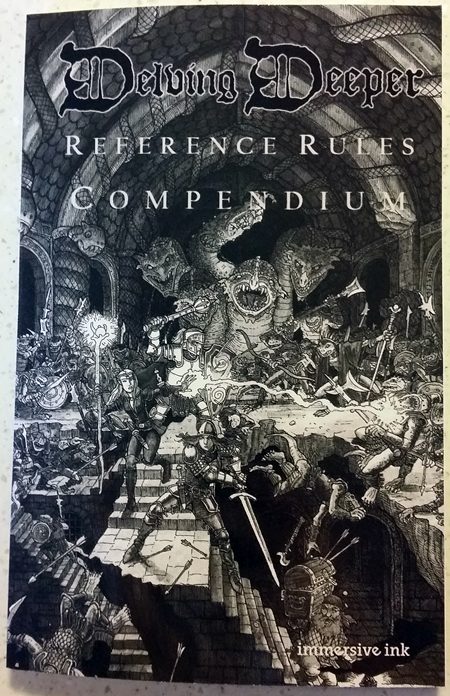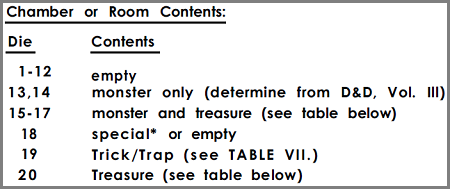My copy of Delving Deeper just came in the mail, and after a thorough skim I quite like it. I was after a retroclone that hews as closely as possible to OD&D[1] (paid link), and at first blush DD seems to fit the bill.
But when I got to the section on dungeon stocking, it looked pretty different from OD&D. Let’s poke that bit and crunch the numbers, like I did with B/X D&D vs. Labyrinth Lord dungeon stocking.

OD&D vs. Delving Deeper
Both games assume that the GM is placing some things by hand before switching to random generation. In OD&D, that’s tricks, traps, and important treasures; in DD, it’s just important treasures (more on this later on!).
Here are the odds in OD&D:
- Monster: 16.67%
- Empty: 59.25%
- Monster with treasure: 16.67%
- Unguarded treasure: 7.41%
Here are the odds for dungeon stocking in DD:
- Monster: 22.22%
- Empty room: 44.45%
- Treasure guarded by monster: 16.66%
- Unguarded treasure: 8.34%
- Treasure guarded by trap: 2.78%
- Trick or trap: 5.56%
First, treasure: You’ve got a 24.08% chance that a given room contains treasure in OD&D, compared to a 27.78% chance in DD — basically the same. That’s awesome, because it indicates a similar balance of risk vs. reward, and a similar incentive to explore, in both games.
The first four categories in DD’s table correspond to the four categories in OD&D, so we can compare apples to apples in those cases — and they’re really close. The biggest difference is the chance of an empty room (without treasure), which is a whopping 14.8% higher in OD&D than in DD. That just about covers the increased chance of meeting a monster, finding a trap, or finding trapped treasure — the latter two of which aren’t options in OD&D’s chart.
And that’s the biggest difference, of course: DD’s two additional categories, which aren’t present at all in OD&D. Since Delving Deeper’s goal is “faithful emulation of the original 1974 edition,” where did those extra categories come from, and why are they there?
I have two guesses, one reasonable and one perhaps a bit more fun.
The reasonable one
My best guess as to the origin of those two categories is that DD’s authors wanted to provide a clarified take on OD&D’s system for random dungeon stocking, which entailed backing into the parts that OD&D doesn’t randomize.
OD&D includes a section called “Tricks and Traps,” and also notes “It is a good idea to thoughtfully place several of the most important treasures.” Those directives map pretty well to DD’s two “extra” categories.
It’s also significant that, unlike OD&D, DD only proposes that the GM place the “principal treasures” before rolling for the rest of the level — not tricks and traps. If you’re not going to stock those by hand, then they need to appear on the chart.
Legal “cover” may also come into play, too. By presenting stocking differently than OD&D, DD establishes a degree of variation between the two systems. At the same time, the percentages are mostly close enough that OD&D’s intent is preserved.
The Strategic Review
The fun guess involves pure speculation. When I was reading the DD section on dungeon stocking, the categories rang a bell — I thought I’d seen them in an early issue of The Strategic Review. Here’s the relevant chart from Gary Gygax’s article on random dungeon generation for solo play in issue #1:

Bingo! Those categories are almost identical to the ones in DD. The biggest difference is “Treasure guarded by trap” in DD vs. “Special or empty” in TSR; I’d argue those are pretty similar. (Crunching the percentages, they line up almost perfectly with OD&D, with a bit of fuzz factor in order to fit in the additional two categories. They don’t line up as perfectly with DD, but they’re still pretty close.)
I don’t know if Delving Deeper took that TSR article into account, but I do know that it encompasses the 1974 boxed set, Chainmail, and “some ‘zine commentary of the time (most particularly the FAQ that appeared in The Strategic Review and the unofficial untested thief as it appeared in The Great Plains Game Players Newsletter).” Given that the FAQ didn’t appear until issue #2 of TSR, contemplating an article in TSR #1 seems reasonable.[2]
Conclusions
Like B/X and Labyrinth Lord, Delving Deeper’s approach to dungeon stocking incentivizes the same play style as the system found in OD&D. Some treasure is unguarded, and about the same percentage of rooms in both games contain treasure.
Delving Deeper does a great job of breaking down the math used to stock an OD&D dungeon, and then matching it quite closely in the four categories that both games share. It then formalizes a part of the dungeon stocking process — tricks and traps — that OD&D leaves informal, and adjusts the percentages to make everything fit.
In a vacuum, that makes DD dungeon stocking look different from OD&D dungeon stocking — more traps, fewer empty rooms. But it’s not apples to apples, because DD expands the random generation system to encompass more dungeon elements.
It’s hard to directly compare OD&D’s combination of manual placement (tricks, traps, and principal treasures) and randomization to DD’s more fully randomized approach, which only involves manual placement of the big treasures. One GM might stick traps in 10% of her dungeon rooms, while another only traps 5% of chambers.
On the whole, it seems like it would have been easier to follow OD&D’s example exactly, sticking with four categories and matching the percentages more closely. But on balance I like that Delving Deeper attempts to fold the rest of the dungeon stocking process into one table, and that it does so by remaining faithful to OD&D’s intent — and, perhaps, to Gary’s take in The Strategic Review.
Update from Simon Bull
Over on G+, Simon Bull commented on writing this section of Delving Deeper:
DD V3-V4 were written, largely, mid 2013 to mid 2014–so a while back now–but being “legally different” to the original was an ever-present design consideration throughout.
I can remember spending a lot of time trying to get the dungeon stocking probabilities “just so”. I was aware that EGG’s expanded dungeon stocking article in the SR included the possibility of random traps and, although I don’t remember my precise rationale now, it probably helped me to “justify” adding traps to V4’s method of randomisation.
I can also remember being a bit dissatisfied with V4’s frequency of empty rooms, but I figured it was the least disruptive way I could add traps into the mix.
FWIW, I do consider the random dungeon stocking section–and particularly randomisation of monsters–a bit of a weakness in V4. However, I have done a lot a more thinking about it since then, and this element of game is presented far more cleanly in V5.
Thanks, Simon!
[1] “OD&D” can sometimes be a fuzzy term. Is it just the three original booklets? Those three plus Supplement I: Greyhawk (paid link)? All seven LBBs? What about the FAQ in The Strategic Review #2, or the prototype thief class that appeared in a fanzine before it was published in Greyhawk? I’m most interested in the three original booklets plus the FAQ, so that’s what I have in mind in this post.
[2] While I’m out on a limb, given that Gary published this article in 1975, just a year after OD&D came out, I wonder whether or not the percentages for “Special or empty” and “Trick/trap” in TSR #1 might not be pretty close to what he used in his home games when stocking a dungeon level. I have no way of knowing, but it’s fun to think about.
